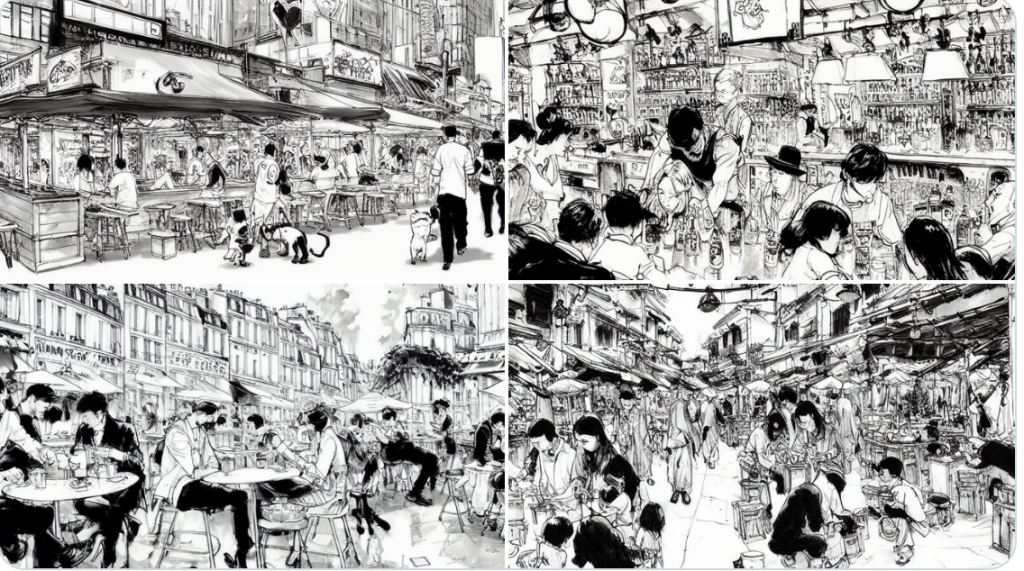
A former French game developer, known online as 5you, posted this generated image on Twitter as an homage to a South Korean artist named Kim Jung Gi. Other artists objected to the appropriation of his style, which involved drawing street scenes rapidly.
AI-Generated Art Stirs Debate on Its Authenticity, Artistic Integrity in Competing with Humans
If you are an art lover or have an interest in the latest craze of artists using AI and image generators, then perhaps you have already made a judgment on this issue. It is causing quite a stir in art circles around the world. Perhaps you recall the winner from the Colorado State Fair in October of this year?
Jason Allen, a video game designer in Pueblo, Colorado, spent roughly 80 hours working on his entry to the Colorado State Fair’s digital arts competition. Judges awarded him first place, which came with a $300 prize.
But when Allen posted about his win on social media late last month, his artwork went viral—for all the wrong reasons.
Allen’s victory took a turn when he revealed online that he’d created his prize-winning art using Midjourney, an artificial intelligence program that can turn text descriptions into images. He says he also made that clear to state fair officials when he dropped off his submission, called Théâtre D’opéra Spatial. But over the last week or so, his blue ribbon has sparked an impassioned debate about what constitutes art
We could talk about what constitutes art for days and days on end. But there are other areas in the world that are also taken aback by AI Images. In South Korea for instance the problem exploded
On October 3, renowned South Korean illustrator Kim Jung Gi passed away unexpectedly at the age of 47. He was beloved for his innovative ink-and-brushwork style of manhwa, or Korean comic-book art, and famous for captivating audiences by live-drawing huge, intricate scenes from memory.
Just days afterward, a former French game developer, known online as 5you, fed Jung Gi’s work into an AI model. He shared the model on Twitter as an homage to the artist, allowing any user to create Jung Gi-style art with a simple text prompt. The artworks showed dystopian battlefields and bustling food markets — eerily accurate in style, and, apart from some telltale warping, as detailed as Jung Gi’s own creations.
The outrage was instantaneous
“Kim Jung Gi left us less than [a week ago] and AI bros are already ‘replicating’ his style and demanding credit. Vultures and spineless, untalented losers,” read one viral post from the comic-book writer Dave Scheidt on Twitter. “Artists are not just a ‘style.’ They’re not a product. They’re a breathing, experiencing person,” read another from cartoonist Kori Michele Handwerker. .
Far from a tribute, many saw the AI generator as a theft of Jung Gi’s body of work.
Is Comparison Even Equitable?
The nation of Japan had major friction with artists who expressed almost the exact same kind of outrage. AI has hit a nerve. And it might not be so much that there is AI art, but that it is competing with human art. Human judges.
Japanese AI startup Radius5 was one of the first companies to touch a nerve when, in August, it launched an art-generation beta called Mimic that targeted anime-style creators. Artists could upload their own work and customize the AI to produce images in their own illustration style; the company recruited five anime artists as test cases for the pilot.
Almost immediately, on Mimic’s launch day, Radius5 released a statement that the artists were being targeted for abuse on social media. “Please refrain from criticizing or slandering creators,” the company’s CEO, Daisuke Urushihara, implored the swarm of Twitter critics. Illustrators decried the service, saying Mimic would cheapen the art form and be used to recreate artists’ work without their permission.
And that is the question in the article from restofworld.org. They present examples of what is or is not art from different points of view around the globe. But they are all similar. In a polarized world, you either love it or hate it. The image is either art or not. But that’s the beauty of AI art or human art.
It is up to each of us to assign a value to an art piece we view or not. No matter who made the art it is considered art in many people’s minds.
However, is it fair to even compare AI-generated images with human images that have been brushed on canvas for thousands of years? Can you really compare them?
read more at restofworld.org







Leave A Comment